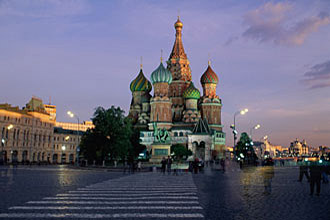 |
 Red Square began life as a slum, a shanty town of wooden huts clustered beneath the Kremlin walls that housed a collection of peddlers, criminals and drunks whose status left them outside the official boundaries of the medieval city. It was cleared on the orders of Ivan III at the end of the 1400's, but remained the province of the mob, the site of public executions, and rabble rousing, until much later.
Red Square began life as a slum, a shanty town of wooden huts clustered beneath the Kremlin walls that housed a collection of peddlers, criminals and drunks whose status left them outside the official boundaries of the medieval city. It was cleared on the orders of Ivan III at the end of the 1400's, but remained the province of the mob, the site of public executions, and rabble rousing, until much later.
The square's name has nothing to do with communism or with the color of many of its buildings. In fact it derives from the word 'krasnyi', which once meant 'beautiful', and has only come to mean 'red' in contemporary Russian. The name became official in the middle of the 17th century - previously it had been Trinity Square, due to the Trinity Cathedral, the predecessor of St. Basil's. Popularly, it was also known as 'Fire Square', reflecting the number of times medieval Moscow burned. During the Mongol and Tartar invasions, it was the site of fierce fighting, and right up until the end of the 17th century cannon stood ready to defend the square.
Red Square came into its own in the 20th Century, when it was most famous as the site of official military parades demonstrating to the world the might of the Soviet armed forces. Two of these will be remembered forever. The first was the parade of 7 November 1941, when columns of young cadets marched through the square and straight on to the frontline, which by that point was less than 50km from Moscow. The second was the victory parade on 24 June 1945, when two hundred Nazi standards were thrown in front of the mausoleum and trampled by mounted Soviet commanders in celebration. The year 2000 saw the return of troops to Red Square, with a parade to mark the 50th anniversary of the end of World War Two.
Since Perestroika, however, the emphasis has moved away from official pomp, and Red Square has been used increasingly for rock concerts, big classical music performances and a whole range of large-scale events from fashion shows to festivals of circus art. Moscow met the millennium here with a huge firework display and street party.
Today it's hard to think of a place that is more beloved of Muscovites and visitors to the city. The varied beauty of the architecture and the magical atmosphere belie the square's often brutal and bloody history, but the combination makes Red Square a truly fascinating place that you'll want to come back to again and again.
|
 |

 Red Square began life as a slum, a shanty town of wooden huts clustered beneath the Kremlin walls that housed a collection of peddlers, criminals and drunks whose status left them outside the official boundaries of the medieval city. It was cleared on the orders of Ivan III at the end of the 1400's, but remained the province of the mob, the site of public executions, and rabble rousing, until much later.
Red Square began life as a slum, a shanty town of wooden huts clustered beneath the Kremlin walls that housed a collection of peddlers, criminals and drunks whose status left them outside the official boundaries of the medieval city. It was cleared on the orders of Ivan III at the end of the 1400's, but remained the province of the mob, the site of public executions, and rabble rousing, until much later.